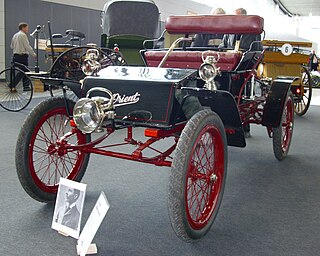
The Winton Motor Carriage Company was a pioneer United States automobile manufacturer based in Cleveland, Ohio. Winton was one of the first American companies to sell a motor car. In 1912 Winton became one of the first American manufacturers of diesel engines.
The Aerocar is an American automobile that was built from 1906 until 1908 in Detroit, Michigan. Backed by Henry Ford's former partner, coal merchant Alexander Malcomson, the short-lived company offered an air-cooled four-cylinder luxury car which sold for $2,800.

The gasoline-powered Oldsmobile Model R, also known as the Curved Dash Oldsmobile, is credited as being the first mass-produced automobile, meaning that it was built on an assembly line using interchangeable parts. It was introduced by the Oldsmobile company in 1901 and produced through 1903; 425 were produced the first year, 2,500 in 1902, and over 19,000 were built in all. When General Motors assumed operations from Ransom E. Olds on November 12, 1908, GM introduced the Oldsmobile Model 20, which was the 1908 Buick Model 10 with a stretched wheelbase and minor exterior changes.

The Ford Model N is an automobile produced by Ford Motor Company; it was introduced in 1906 as a successor to the Models A and C as the company's inexpensive, entry-level line. It was built at the Ford Piquette Avenue Plant.

Elmore Manufacturing Company was a manufacturer of veteran and brass era automobiles and bicycles (1893–97), headquartered at 504 Amanda Street, Clyde, Ohio, from 1893 until 1912. The company took its name from a small parcel of land in Clyde with the name Elmore associated with it where a stave mill was established originally, then evolved into bicycle production. The village of Elmore, Ohio is located 20 mi (32.2 km) to the east. Founded by Harmon Von Vechten Becker and his two sons, James and Burton, the Elmore used a two-stroke engine design, in straight twin or single-cylinder versions. They later produced a straight-3 followed by a straight-4 beginning in 1906 until production ended in 1912. The company advertising slogan was "The Car That Has No Valves", referring to the two-stroke engine.

The Knox Automobile Company was a manufacturer of automobiles in Springfield, Massachusetts, United States, between 1900 and 1914. Knox also built trucks and farm tractors until 1924. They are notable for building the very first modern fire engine in 1905.

Waltham Manufacturing Company (WMC) was a manufacturer of bicycles, motorcycles, motorized tricycles and quadricycles, buckboards, and automobiles in Waltham, Massachusetts. It sold products under the brand names Orient, Waltham, and Waltham-Orient. The company was founded in 1893, moving to self-propelled vehicles after 1898.

Stevens-Duryea was an American manufacturer of Veteran and Brass Era automobiles in Chicopee Falls, Massachusetts, between 1901 and 1915 and Vintage Cars from 1919 to 1927.

Templar was a manufacturer of automobiles in Lakewood, Ohio from 1917 to 1924. The company was named for the Knights Templar and used a Maltese Cross as an emblem.

The first Cadillac automobiles were the 1903 Model built in the last quarter of 1902. These were 2-seater "horseless carriages" powered by a reliable and sturdy 10 hp (7 kW) single-cylinder engine developed by Henry Martyn Leland and built by Leland and Faulconer Manufacturing Company of Detroit, of which Henry Leland was founder, vice-president and general manager.

Single Center Spring Buggy Company was an American carriage and automobile manufacturer based in Evansville, Indiana. The Single Center factory manufactured the Zentmobile, Zent, Windsor, Worth, Single Center, Evansville, Simplicity and Traveler automobiles from 1903 to 1910.
The Franklin Engine Company was an American manufacturer of aircraft engines. Its designs were used primarily in the civilian market, both in fixed wing and helicopter designs. It was briefly directed towards automobile engines as part of the Tucker Car Corporation, returning to aviation when that company failed. The company was later purchased by the Government of Poland.

Western Tool Works was a pioneering brass era automobile manufacturer in Galesburg, Illinois. The company made Gale automobiles from 1904 to 1910. Early Gale runabouts were notable for having bodywork hinged at the rear of the car that could be lifted to ease access to the engine, essentially making the entire body the hood.
The Success Automobile Manufacturing Company was a brass era United States automobile manufacturer, located at 532 De Ballviere Avenue, St. Louis, Missouri, in 1906.

The Black was a brass era United States automobile, built at 124 East Ohio Street, Chicago, Illinois, in 1906.

The Metz Company was a pioneer brass era automobile maker established by Charles Herman Metz in Waltham, Massachusetts, from 1909 to 1922.

Daniels Motor Company was a pioneer brass era American automobile company, founded in 1915 by George E. Daniels with Neff E. Parish. George Daniels was a known lawyer, engineer, and mechanic. He was considered the best motorcar designer in the United States. Neff Parish had his own automobile parts and framing manufacturing company. Neff was the creator of the time's highest-grade heat-treated alloy steel frames, respected in the steel industry. Daniels Motor Company produced 1,500 high-quality automobiles between 1916 and 1924, branding themselves as “the distinguished car with just a little more power than you will ever need”, and “The aristocrat of American cars”.

Hatfield Motor Vehicle Company was a pioneer brass era American automobile company, built in Miamisburg, Ohio, in 1907 and 1908.
The Franklin Sedan was manufactured by the H. H. Franklin Manufacturing Company Company of Syracuse, New York.
Brennan Motor Manufacturing Company (1897–1972) of Syracuse, New York, was an early manufacturer of automobile engines. From 1902 until 1908, the company produced the Brennan automobile however, after the demise of the automobile enterprise, the company again turned their focus to automobile engines and later marine engines. They were in business for 75 years when the company closed its doors in 1972.






















